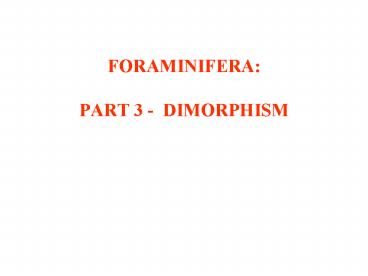FORAMINIFERA: PART 3 - DIMORPHISM - PowerPoint PPT Presentation
1 / 20
Title:
FORAMINIFERA: PART 3 - DIMORPHISM
Description:
FORAMINIFERA: PART 3 - DIMORPHISM DIMORPHISM Dimorphic life cycle is complex Alternation of sexual and asexual generations Microspheric form Megalospheric I form ... – PowerPoint PPT presentation
Number of Views:311
Avg rating:3.0/5.0
Title: FORAMINIFERA: PART 3 - DIMORPHISM
1
FORAMINIFERAPART 3 - DIMORPHISM
2
DIMORPHISM
- Dimorphic life cycle is complex
- Alternation of sexual and asexual generations
- Microspheric form
- Megalospheric I form
- Trimorphism may be present
- Add a megalospheric II form
- Creates taxonomic problems
- Some once designated as separate species
- Some were even designated as separate genera
3
DIMORPHISM
- Microspheric form
- Larger
- More chambers
- Smaller proloculus
- Early stages may be different
- Illustrates "ontogeny recapitulates phylogeny"
- Megalospheric form
- Smaller
- Fewer chambers
- Larger proloculus
- Early stages missing
4
Alternation of Generations
- Duration of a cycle varies
- 1 year in tropics
- 2-3 years at higher latitudes
- Cycle stages vary
- Among different Foraminifera
- Short circuits occur
- Microspheric (asexual or agamont or schizont)
form - Diploid Multinucleated
- Reproduces asexually
- Usually during the winter
- Protoplasm withdraws
- Meiosis (reduction division) occurs
- Haploid cells produced
- Proloculus forms
- Release of young megalospheric (gamont) forms
5
Alternation of Generations
- Megalospheric (gamont) form
- One nucleus until reproduction
- Matures during the summer
- Withdraws protoplasm and undergoes mitosis
- Haploid, biflagellated gametes produced
- Same haploid chromosome number as parent
- Released from test of parent which empties
- Gametes fuse with gametes from another gamont
- Diploid zygote (first cell) results
- Secretes a small proloculus
- Zygote develops a microspheric test (agamont or
schizont)
6
Foram Life Cycle
- Alternation of generations
Megalospheric
Microspheric
( agamont)
7
Foram Life Cycle
- Alternation of generations
8
Alternation of Generations
9
Gamontogamy
Megalospheric
Microspheric
10
Gamontogamy
11
Asexual Reproduction
12
Agamontic Asexual Reproductions May Repeat Many
Times
13
Autogamy
14
Gametogamy
15
Dimorphism
(sexual)
- What is the 3rd mode on this curve?
16
Dimorphism
- Cornuspira sp. with embryonic coil at the center
of the microspheric form that is lacking in the
megalospheric form
17
Dimorphism
18
Dimorphism
- Summary comparison between microspheric and
megalospheric tests of the same species
19
Examples of Trimorphism
- Trimorphism
- A) Nodosaria sp.
- B) Dentalina sp.
- C) Marginulina sp.
- Pyrgo sp.
- D) Microspheric quinqueloculine to triloculine to
biloculine stages (smallest proloculus) - E) Megalospheric I triloculine to biloculine
stages - F) Megalospheric II biloculine stage only
(largest proloculus)
20
END OF FILE
- Vulvulina sp.
- Is this microspheric or megalospheric?
- Last 2 chambers
- Middle 12 chambers
- First 4 chambers































